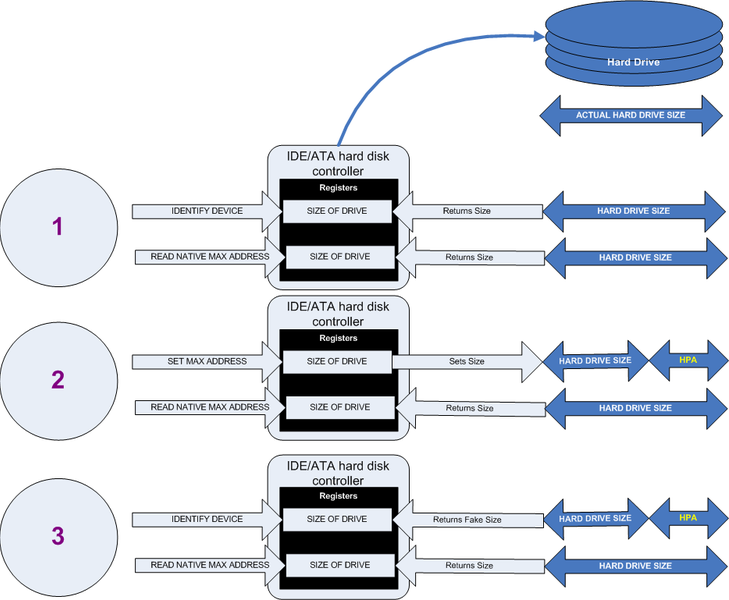File:Hpacreate.png

Size of this preview: 729 × 600 pixels. Other resolutions: 292 × 240 pixels | 584 × 480 pixels | 935 × 769 pixels.
Original file (935 × 769 pixels, file size: 69 KB, MIME type: image/png)
Summary
[edit]The diagram shows how an Host Protected Area (HPA) is created.
- IDENTIFY DEVICE returns the true size of the hard drive. READ NATIVE MAX ADDRESS returns the true size of the hard drive.
- SET MAX ADDRESS reduces the reported size of the hard drive. READ NATIVE MAX ADDRESS returns the true size of the hard drive. An HPA has been created.
- IDENTIFY DEVICE returns the now fake size of the hard drive. READ NATIVE MAX ADDRESS returns the true size of the hard drive, the HPA is in existence.
Licensing
[edit]I, the copyright holder of this work, hereby publish it under the following licenses:
 | Permission is granted to copy, distribute and/or modify this document under the terms of the GNU Free Documentation License, Version 1.2 or any later version published by the Free Software Foundation; with no Invariant Sections, no Front-Cover Texts, and no Back-Cover Texts. Subject to disclaimers. |
| This work is licensed under the Creative Commons Attribution-ShareAlike 3.0 License. This licensing tag was added to this file as part of the GFDL licensing update. |
| This work is licensed under the Creative Commons Attribution 2.5 License. |
You may select the license of your choice.
 | This file is a candidate to be copied to Wikimedia Commons. Any user may perform this transfer; refer to Wikipedia:Moving files to Commons for details. If this file has problems with attribution, copyright, or is otherwise ineligible for Commons, then remove this tag and DO NOT transfer it; repeat violators may be blocked from editing. Other Instructions
| ||
| |||
File history
Click on a date/time to view the file as it appeared at that time.
| Date/Time | Thumbnail | Dimensions | User | Comment | |
|---|---|---|---|---|---|
| current | 05:46, 29 October 2006 |  | 935 × 769 (69 KB) | Kim Meyrick (talk | contribs) | The diagram shows how an Host Protected Area (HPA) is created. 1. IDENTIFY DEVICE returns the true size of the hard drive. READ NATIVE MAX ADDRESS returns the true size of the hard drive. 2. SET MAX ADDRESS reduces the reported size of the hard drive. R |
| 05:44, 29 October 2006 |  | 935 × 769 (69 KB) | Kim Meyrick (talk | contribs) | The diagram shows how an Host Protected Area (HPA) is created. 1. IDENTIFY DEVICE returns the true size of the hard drive. READ NATIVE MAX ADDRESS returns the true size of the hard drive. 2. SET MAX ADDRESS reduces the reported size of the hard drive. R | |
| 05:52, 15 October 2006 |  | 935 × 769 (68 KB) | Kim Meyrick (talk | contribs) | The diagram shows how a Host Protected Area (HPA) is created. 1. IDENTIFY DEVICE returns the true size of the hard drive. READ NATIVE MAX ADDRESS returns the true size of the hard drive. 2. SET MAX ADDRESS reduces the reported size of the hard drive. RE |
You cannot overwrite this file.
File usage
The following page uses this file:


 French
French Deutsch
Deutsch